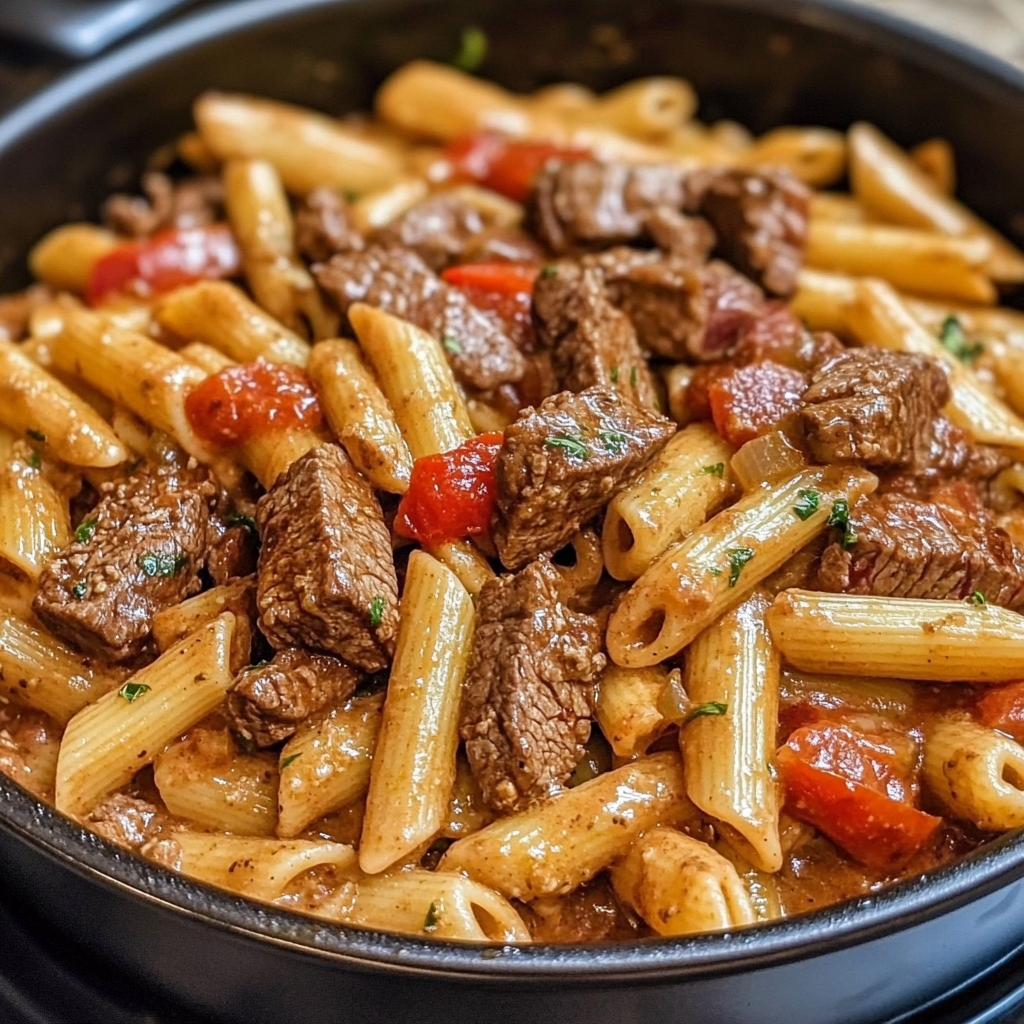Sharing is caring!
One-Pot Steak Pasta: Quick & Easy Flavor-Packed Dinner in 30 Minutes
Craving a hearty, restaurant-quality meal without the hassle? This steak pasta recipe is your answer. Perfect for busy weeknights, it combines tender steak, al dente pasta, and rich flavors—all cooked in one pot for minimal cleanup. Whether you’re a seasoned chef or a kitchen newbie, this dish delivers gourmet taste with effortless prep.
I’ve perfected this recipe over years of testing, ensuring it’s foolproof and packed with tips for the best results. The secret? Searing the steak first to lock in juices, then simmering it with aromatics and pasta for a deeply savory sauce. Pair it with a side of garlic bread or a crisp salad for a complete meal.
Why choose steak pasta? It’s versatile (swap ingredients based on what’s in your fridge), budget-friendly (using affordable cuts like flank or sirloin), and a crowd-pleaser. Plus, it’s ready in 30 minutes—faster than takeout! Let’s dive into this flavor-packed dish that’ll become a staple in your recipe rotation.
Table of Contents
Ingredients List
- 1 lb sirloin steak, thinly sliced
- 8 oz penne pasta (or your favorite pasta shape)
- 2 tbsp olive oil
- 3 cloves garlic, minced
- 1 small onion, diced
- 1 red bell pepper, sliced
- 1 cup mushrooms, sliced
- 2 cups beef broth
- 1/2 cup heavy cream
- 1/4 cup grated Parmesan cheese
- 1 tsp Italian seasoning
- Salt and black pepper to taste
- Fresh parsley, chopped (for garnish)
Timing
- Prep Time: 10 minutes
- Cook Time: 20 minutes
- Total Time: 30 minutes
- Serves: 4 people
Step-by-Step Instructions
Making this steak pasta is a breeze with these simple steps. Follow along for a perfectly cooked, flavor-packed meal every time.
Step 1: Prep the Steak
Season your steak generously with salt and pepper. Heat olive oil in a large pot over medium-high heat. Sear the steak for 3-4 minutes per side until browned. Remove and let it rest before slicing thinly.
Step 2: Sauté the Aromatics
In the same pot, add diced onions and minced garlic. Cook until fragrant (about 2 minutes). Stir in sliced mushrooms and cook until softened.
Step 3: Cook the Pasta
Pour in beef broth and bring to a boil. Add uncooked pasta and simmer for 10-12 minutes, stirring occasionally, until al dente. The pasta will absorb the rich broth for extra flavor.
Step 4: Combine & Serve
Return the sliced steak to the pot. Stir in heavy cream and grated Parmesan. Garnish with fresh parsley and serve hot. For a lighter twist, try our healthy apple oat muffins as a side.
Nutritional Information
This steak pasta packs protein and flavor while keeping calories in check. Here’s the breakdown per serving (based on 4 servings):
- Calories: 520 kcal
- Protein: 32g
- Carbs: 45g
- Fiber: 3g
- Fat: 22g
For a balanced meal, pair it with a side like braised short ribs or a lighter option such as Cuban black beans. Want dessert? Try our almond amaretti cookies or this pumpkin cheesecake for a sweet finish.
Healthier Alternatives for the Recipe
Want to enjoy this steak pasta with a lighter twist? Try swapping ingredients for healthier options without sacrificing flavor. Use lean cuts like sirloin or flank steak instead of ribeye to reduce saturated fat. For a plant-based version, substitute portobello mushrooms or lentils for a protein-packed alternative.
Replace heavy cream with Greek yogurt or coconut milk for a creamy texture with fewer calories. Whole wheat or chickpea pasta adds fiber, while zucchini noodles (zoodles) keep it low-carb. Skip the butter and sauté veggies in olive oil or avocado oil for heart-healthy fats. A sprinkle of nutritional yeast can mimic cheesy richness if you’re avoiding dairy.
For more inspiration, check out our healthy breakfast ideas or explore protein-rich legume dishes to balance your meals.
Serving Suggestions
Elevate your steak pasta with complementary sides and garnishes. A crisp arugula salad with lemon vinaigrette cuts through the richness, while roasted garlic bread (like these almond cookies) adds crunch. For a veggie boost, serve with sautéed spinach or roasted cherry tomatoes.
Pair it with a glass of bold red wine or a spiced mocktail for a cozy dinner vibe. Leftovers? Transform them into a next-day pasta bake topped with mozzarella, or try our fruit cobbler for dessert. Craving more steak ideas? Herb-crusted dishes can inspire your next meal.
Common Mistakes to Avoid
Making steak pasta seems simple, but small errors can impact flavor and texture. Here are common pitfalls:
- Overcooking the steak: Searing it too long makes it tough. Aim for medium-rare to retain juiciness.
- Underseasoning: Pasta absorbs salt, so season generously. Taste as you go!
- Using watery sauces: Pat steak dry before cooking to avoid excess liquid. For creamier results, try our rich sauce techniques.
- Overcrowding the pan: Cook steak in batches if needed. A single layer ensures even browning.
For more protein tips, check out perfectly cooked beef methods or avoid common simmering mistakes with legumes.
Storing Tips for the Recipe
Keep your steak pasta fresh with these storage hacks:
- Refrigerate promptly: Store in airtight containers within 2 hours. Consume within 3 days.
- Freeze for longer storage: Portion into freezer bags (up to 1 month). Thaw overnight before reheating.
- Reheat gently: Use a skillet with a splash of broth to revive creaminess. Avoid microwaving—it dries out steak.
Pair leftovers with apple oat muffins for a balanced meal. For more ideas, explore freezer-friendly dishes or quick dessert pairings.
Conclusion
This one-pot steak pasta recipe is a game-changer for busy weeknights. It delivers restaurant-quality flavor in just 30 minutes with minimal cleanup. The tender steak, al dente pasta, and rich sauce create a satisfying meal that’s perfect for family dinners or impressing guests.
If you loved this recipe, try our classic banana bread for dessert or explore more quick dinner ideas like our cinnamon baked French toast for breakfast-for-dinner nights.
FAQs
Can I use a different cut of beef?
Yes! While sirloin works best, flank steak or ribeye are great alternatives. Just adjust cooking times as thinner cuts cook faster.
How do I prevent the pasta from sticking?
Stir frequently during cooking and ensure enough liquid covers the pasta. Adding a splash of reserved pasta water helps create a silky sauce.
Can I make this dish ahead?
It’s best served fresh, but you can prep ingredients in advance. Store cooked steak and pasta separately, then combine when reheating.
What’s the best way to reheat leftovers?
Add a tablespoon of water or broth and reheat gently on the stovetop over medium-low heat, stirring frequently.
Can I freeze steak pasta?
We don’t recommend freezing as the pasta texture changes. For freezer-friendly meals, try our fruit cobbler instead.











